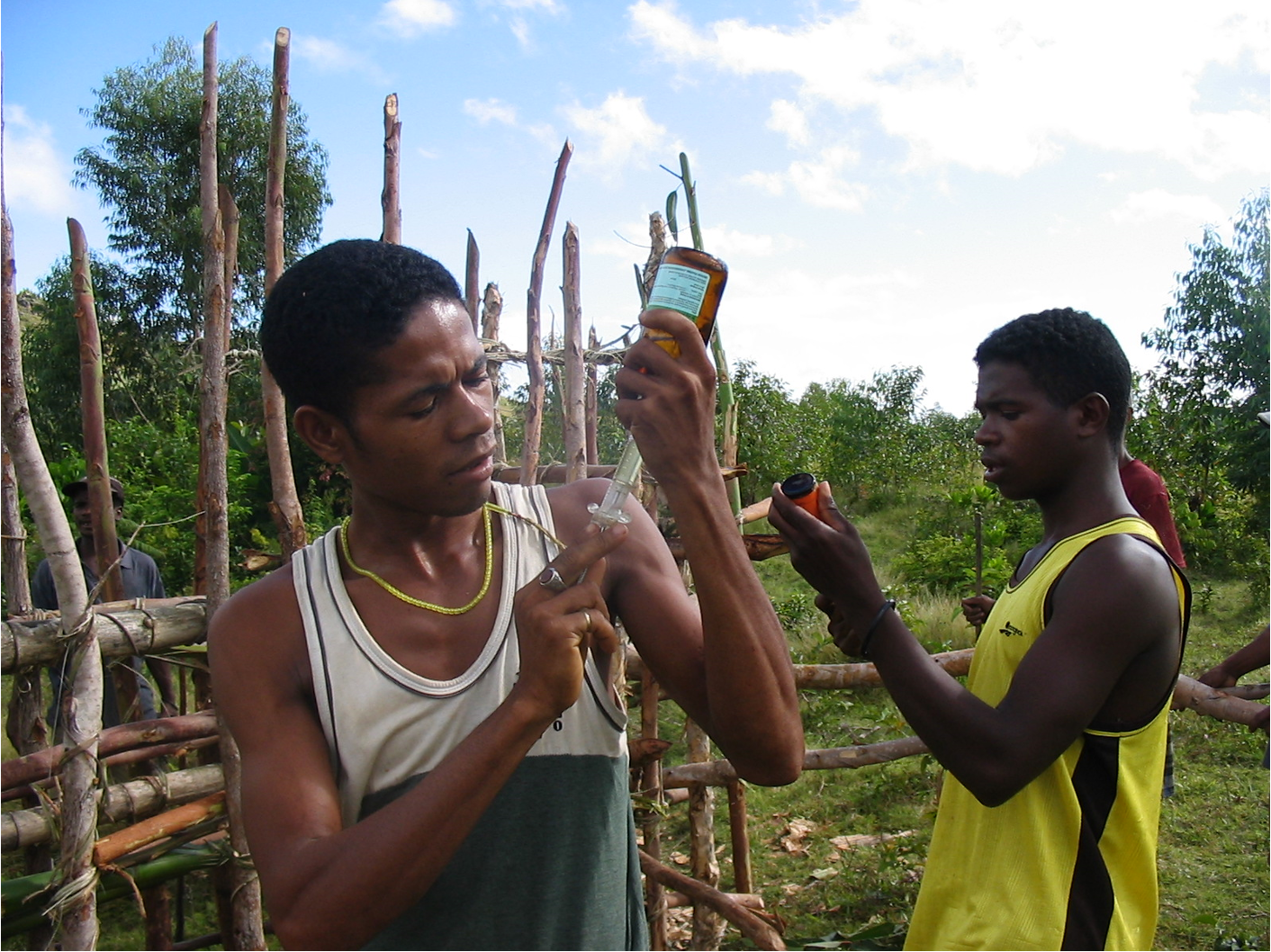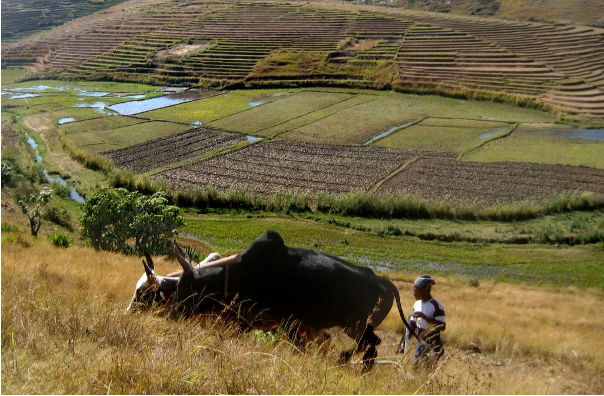The concept of Community Animal Health workers emerged in Madagascar in the early 1990s. From 1991 to 1993, Agronomes et Vétérinaires Sans Frontières (AVSF) initiated the first CAHW programme in the Amoron’i Mania region by training a dozen CAHWs under the supervision of a private veterinarian. In the light of these initial encouraging results, other systems were set up in the Androy and Anosy regions between 1994 and 2000, again with the support of AVSF. Three private veterinarians were appointed and tasked with supervising 25 CAHWs. These CAHWs provided basic care, took part in vaccination campaigns and trained farmers in good farming practices.
On the strength of these initial successful experiences, the CAHWs/private veterinarian installation model was replicated in the Vakinankaratra, Vatovavy-Fitovinany, Alaotra Mangoro and Atsinanana regions. A total of 115 CAHWs were trained between 2004 and 2011, with financial support from the EU, the French Development Agency (AFD) and the decentralised cooperation programme between the Atsinanana and Normandy regions.
This scaling up was an opportunity for AVSF to refine the methodology for setting up the system: selection process, co-construction and co-organisation of training with private veterinarians and livestock services, improvement of training manuals, reflection on the economic model, and establishment of tripartite contracts to supervise the work of the CAHWs. The training was attested by the award of a local diploma by the livestock services and the issue of a temporary exercise certificate, thus demonstrating the acceptance of the CAHWs by the veterinary services.


CAHWs have made it possible to provide local care to the livestock of their community members, supervise the use of medicines, improve livestock farming practices and act as a relay for the veterinarian in disease surveillance. Although this is only a secondary income-generating activity, CAHWs see advantages that go beyond financial considerations: it allows them to improve their social status within their community, as well as to gain skills and thus improve their own livestock production. To further strengthen their sustainability, some CAHWs joined forces to form associations, in order to facilitate their supply of inputs from the private veterinarian, who is often very far away. These associations also facilitated exchanges between CAHWs (mutual assistance, pooling of equipment, agreement on service prices and negotiations with veterinarians, exchanges of practices and continuing education) and the development of a sense of fellowship. The Madagascar model was a system that had proven its sustainability: according to an external evaluation conducted in 2016, the dropout rate of CAHWs over the last 8 years did not exceed 20%.
In the light of these initial successes, various actors (religious associations, national and international NGOs, government programmes) began to train CAHWs by adapting the duration and content of training to their objectives. This resulted in very heterogeneous levels of training. In addition, the lack of support in the field for these CAHWs by the organisations that had supported them facilitated the transition of some of them into the informal sector, offering low-priced services and products, without any link to veterinarians or livestock services, and thus competing unfairly with properly trained and supervised CAHWs and veterinarians.
Faced with this challenge of quality and control of the animal health services provided, the Ministry, the Directorate of Veterinary Services and AVSF jointly carried out a structuring action between 2012 and 2018 (as part of the EU-funded Project ASARA), based on implementation in the field in the Grand Sud, and aimed at harmonising the CAHW system and strengthening the animal health network.
This harmonisation process consisted of four stages:
1. Review of the situation: a review of the animal health situation was carried out in a number of representative regions of Madagascar to identify the animal health needs of livestock farmers and their expectations of the CAHWs.
2. Defining the responsibilities of the CAHWs (then called MMAV, or veterinary care assistants for animals in Malagasy): this stage took into account the professions that already existed in the territory, the specificity of this new agent and its potential added value. It involved:
-
- The definition of expected activities and required skills according to the needs of farmers, private veterinarians and livestock service technicians.
- The development of training modules and topics, as well as assessment criteria to be used during and after the training.
- The definition of the profile of a CAHW and the selection criteria.
These different chapters constitute the APPSA National Qualification Framework (APPSA being the name finally adopted for CAHWs).
3. The training of trainers (= private veterinarians) and assessors (= Regional Livestock Services) provided by the team of the National Agricultural and Rural Training Engineering Team (ENIFAR), the National Order of Veterinary Surgeons (Veterinary Statutory Body), and the Directorate of Veterinary Services (DSV).
4. The operationalisation: Training, evaluation and monitoring of the CAHWs, with the establishment of tripartite contracts involving the Regional Directorate of Livestock, the private veterinarian and the CAHW and defining the roles and responsibilities of each.
Following this work, readjustments proved necessary to adapt to the diversity of situations, as Paulin Hyac Rakotoarisoa, former Technical Coordinator of AVSF Madagascar, explains:
During the training of trainers, the APPSA National Qualification Framework (NQF) that was developed seemed to the veterinarians of certain regions not to be adapted to their needs. The training of trainers was therefore suspended to make way for workshops to reassess and rewrite the NQF in order to take into account the needs and context of each of the 23 regions of Madagascar. It was during this rewrite that the title ‘MMAV’ was changed to ‘APPSA’ (for “Agent de Proximité en Production et Santé Animale”) in order to give full recognition to the role of these agents in promoting good animal production practices. The final version of the NQF was validated in Antsirabe in January 2022. An implementing decree should now be issued soon.
Collaboration with APPSA is a win-win situation!
When I set up in 2021, I met the APPSA already working in my area and I continued to work with those who were doing their job properly and met the criteria (knowing how to read and write, living in the municipality where they were working, having good physical and moral qualities, and a good reputation in the municipality). The APPSA make our interventions easier, even in areas far from my area of intervention (30-40km). They also ensure disease surveillance and allow us to check information in the field. They obtain their supplies from my practice.
Madagascar’s veterinarians have expressed a need for 3,000 APPSA throughout the country
The DVS has always supported the establishment of community animal health workers, whatever their name. At the national level, the APPSA are part of the animal disease surveillance network in Madagascar (MADSUR), and we are giving careful consideration to their integration into the One Health approach. In Madagascar, there are 204 private veterinarians, who estimate that 3,000 APPSA need to be recruited, when only 1,400 APPSA have been trained throughout Madagascar between 2022 and 2024. It is worth to be noted that this expressed need takes into account the veterinarians’ ability to pay them, and the needs of the farmers are probably even greater.
While the case of Madagascar should serve as an inspiration, there are still challenges to be met:
-
- Strengthening the link between APPSA, private vets and livestock services: for the model to endure, it is necessary to maintain good communication, work rules and respect for each other’s responsibilities as well as fair agreements, particularly on prices. APPSA must comply with the regulations: they must not go beyond their scope of work and must submit their weekly reports to the veterinarian. For their part, veterinarians must provide genuine continuing training for the APPSA they collaborate with, so that they maintain their skills and update their knowledge. The Ministry of Agriculture and Livestock and the VSB should be involved in monitoring compliance with these agreements and sanctions should be imposed in the event of abuse by either party.
-
- Combating the informal medicine circuit: although the tripartite contract commits APPSA to obtaining supplies from the veterinarian of their area, some APPSA obtain supplies elsewhere, particularly from the clandestine medicine depots found in the municipalities because they are easier to access and often cheaper. This phenomenon damages the good relations between APPSA and veterinarians and, more generally, threatens public health (development of antimicrobial resistance, ineffective products, etc.).
-
- Role of veterinary paraprofessionals (VPPs) in the system. In theory, VPPs benefit from clearly defined intervention procedures (decree no. 13069/2012) and are placed under the authority of the VSB and the Groupement de Para-professionnels Vétérinaires de Madagascar (VPP association). It is expected that the VPPs will form part of the veterinary network and be placed under the direction of the private veterinarians. However, at present, few veterinarians have sufficient resources to hire VPPs. As a result, the latter find themselves working as freelancers. In order to avoid the establishment of actors practising outside the planned provisions, thought should be given to the sustainable integration of VPPs into the veterinary/APPSA system in order to strengthen and supplement the range of services available to farmers. In this case, the clarification of the responsibilities and tasks of each party will become even more important.
Currently, AVSF wishes to commit to continuing its support to the Ministry of Agriculture and Livestock to assist in the scaling up of the harmonised APPSA system in several regions of Madagascar. The aim is to set up effective and sustainable local animal health systems, in which the various stakeholders (livestock services, private veterinarians, VPPs, and APPSA) work together and each play their role properly. The expected results are, ultimately, to meet the needs of livestock farmers to develop their herds, strengthen disease surveillance and safeguard public health.


Article written by Alexia Rondeau, Sabine Patricot, Paulin Hyac
